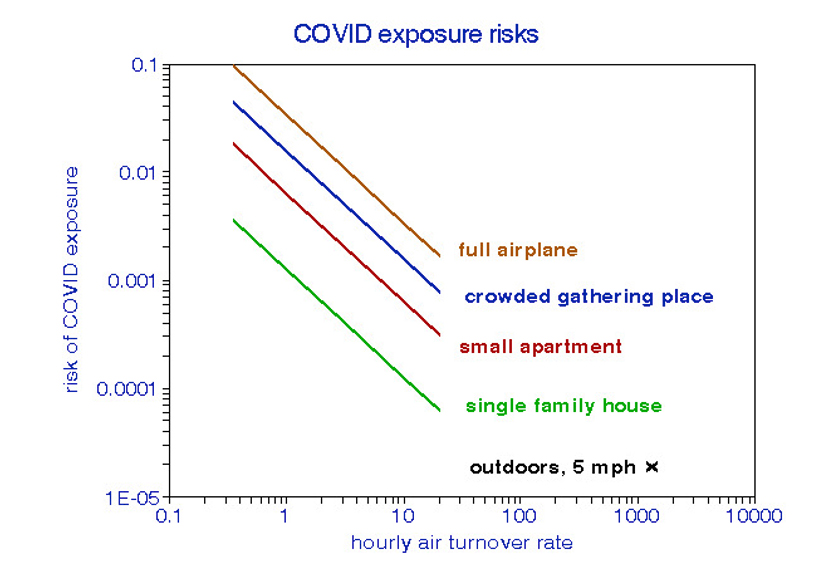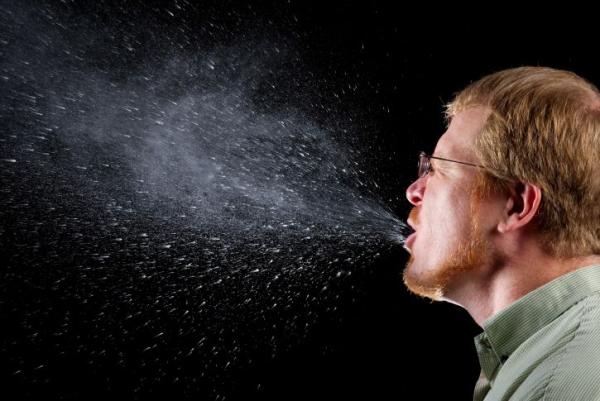Background
In March 2020, a choir rehearsal was designated as a COVID-19 “super-spreader” event. It lasted two and a half hours, and one previously infected person was among the 61 attendees. Fifty-three of them became infected, 33 confirmed by testing, and 20 cases inferred by symptoms. Two of them died, corresponding to a case-fatality rate of about 4%. The report noted that hand sanitizers were used and that hugging and kissing were not allowed. Chairs were spaced approximately 30 inches apart and rows separated by about 55 inches – not exactly “social distancing” -- and the report concluded that transmission by aerosol was likely. Another such aerosol transmission event occurred in a crowded restaurant in China, where 10 of 21 people were infected.
The May 29 Economist reported that 2000 super-spread events have been documented, most of which happened indoors in poorly ventilated spaces and implying airborne transmission. Are there “rules of thumb” that we might apply to assess how risky a venue might be? Short answer – yes; by estimating dilution of the virus in the exhaled breath of an infected individual in situations with various ventilation rates.
A Basic Dilution Model.
Exhalation of an infected person acts as a continuous source of viral aerosol that mixes with clean ambient air. In a closed room, the virus concentration would steadily increase without limit as long as the virus emission persisted, but ventilation would dilute it by adding clean air. The metric of interest here is the ratio of the flow of exhaled virus-laden air to the flow of clean ventilation air. Indoors, dilution comes from ventilation systems (mechanical or windows); outdoors, dilution results from natural wind flowing through the occupied space. The parameters of the analysis are the number of infected persons, the volume of the occupied space, the ventilation flow rate. We postulate some typical exposure configurations to illustrate these principles.
Viral exposure rates
I estimated that an individual exhales 500 ml per breath at 20 breaths a minute, resulting in a volume of 20 cubic feet per hour. Breathing volumes could be doubled or more during singing or cheering. I assumed that 10% of the population is actively spreading the virus; current rates of infection are much lower, with a median state-based rate of about 3%.
Volumes
- Small studio apartment: 400 sq ft, 8 ft ceiling, two occupants.
- Modest single-family house: 2000 sq ft, 8 ft ceilings, four occupants.
- Meeting room, cocktail lounge, performance space: 1600 sq ft, 8 ft ceiling, 100 occupants.
- Small jet aircraft with six passengers per row: 180 occupants.
- Open-air bleachers, 50 by 100 ft, 1000 occupants
Ventilation rates
To determine the magnitude of dilution, I used hourly air turnover rates in the literature. This flow rate represents the time required to replace all of the room air with fresh air
- Minimal residential, 0.35 exchanges per hour
- Recommended indoor, 1.0
- Passenger aircraft, 12
- Subway car, 18
Residential dilution rates would be substantially higher with open windows. I used a steady wind speed of 5 mph to represent minimal outdoor ventilation; for comparison, equivalent indoor wind speeds are of the order of 0.01 mph. To simplify the model, I assume the air is well-mixed, and that location near a vent or next to an infected individual is not a factor.

Model Results
The figure shows the dilutional effects of ventilation on exhaled breath.
For a fixed volume,
- The exhaled contaminated air is further diluted at higher air turnover rates, and the risk of viral spreading is reduced.
- More contamination would be present with more infected individuals in the room, and risks would be increased.
Limitations of the Analysis
This model deals only with rates of exposure and not with infections per se that also depend on viral loads and duration of exposure. Airplane trips and meetings are limited to a few hours, by contrast with residential situations. Perhaps the most risk could result from living with an infected person in a small, poorly ventilated apartment during an extensive lockdown. When in doubt, open the windows!
Conclusions
COVID-19 transmission by aerosol has been supported by detailed analysis of previous super-spreader events. These simple model calculations based on dilution of exhaled virus indicate only minimal aerosol transmission outdoors and illustrate the variability encountered indoors.



